Competitive Strategy Analysis: Tools and Frameworks Report - BUS 101
VerifiedAdded on 2021/06/14
|7
|1684
|40
Report
AI Summary
This report delves into competitive strategy, exploring crucial frameworks such as SWOT analysis, PESTLE analysis, and Porter's Five Forces. It emphasizes the significance of these tools in achieving profitability and growth by considering both internal and external factors. The report examines each framework in detail, providing real-world examples like Tesco and Tesla to illustrate their application. Porter's Five Forces analysis is presented, highlighting the impact of threats of new entrants, supplier power, buyer power, competitive rivalry, and the threat of substitutes. The SWOT analysis explores strengths, weaknesses, opportunities, and threats, while the PESTLE analysis examines political, economic, social, technological, legal, and environmental factors. The report concludes by underscoring the importance of these tools for effective market analysis and strategic decision-making, essential for any business aiming to gain a competitive advantage and achieve its goals.
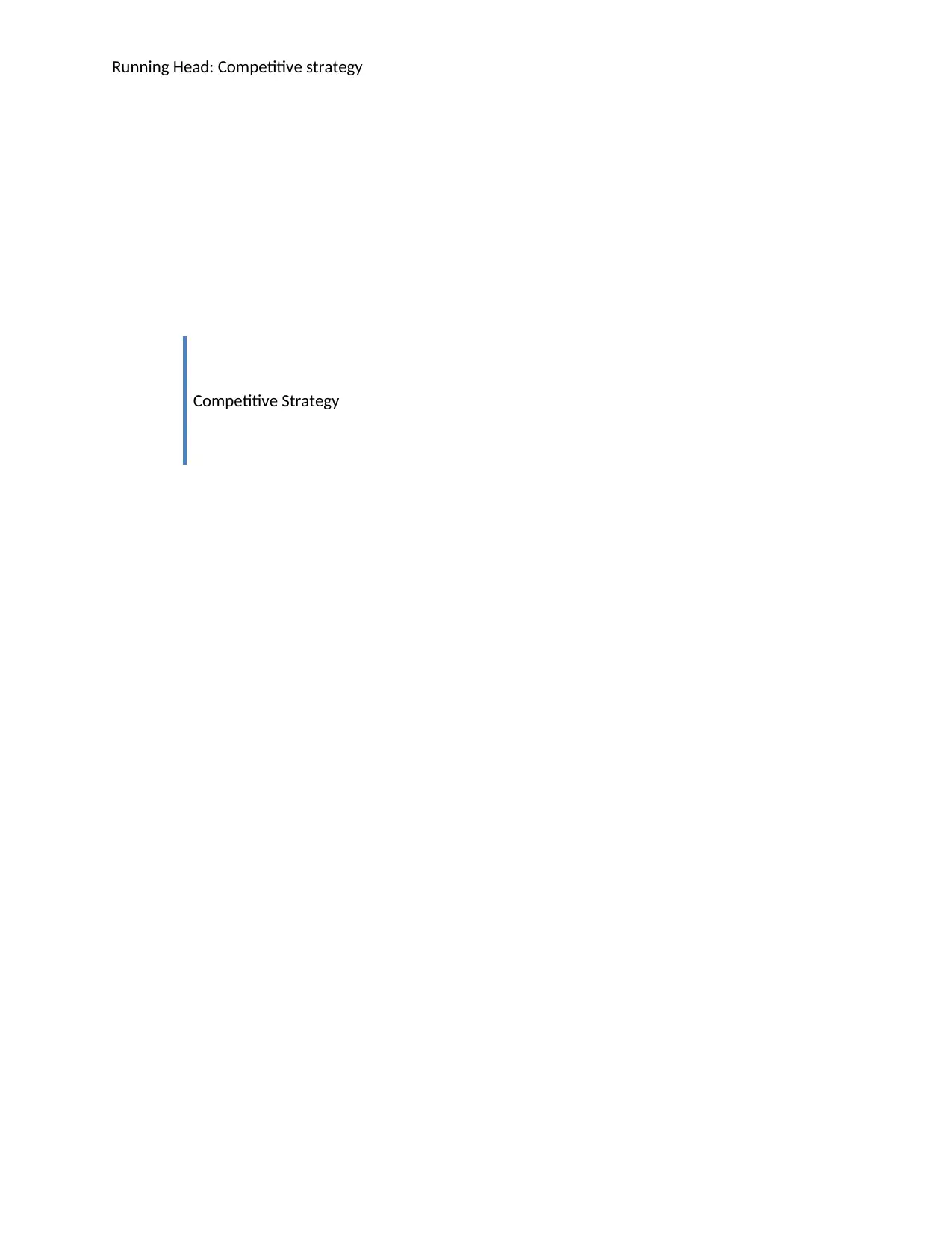
Running Head: Competitive strategy
Competitive Strategy
Competitive Strategy
Paraphrase This Document
Need a fresh take? Get an instant paraphrase of this document with our AI Paraphraser
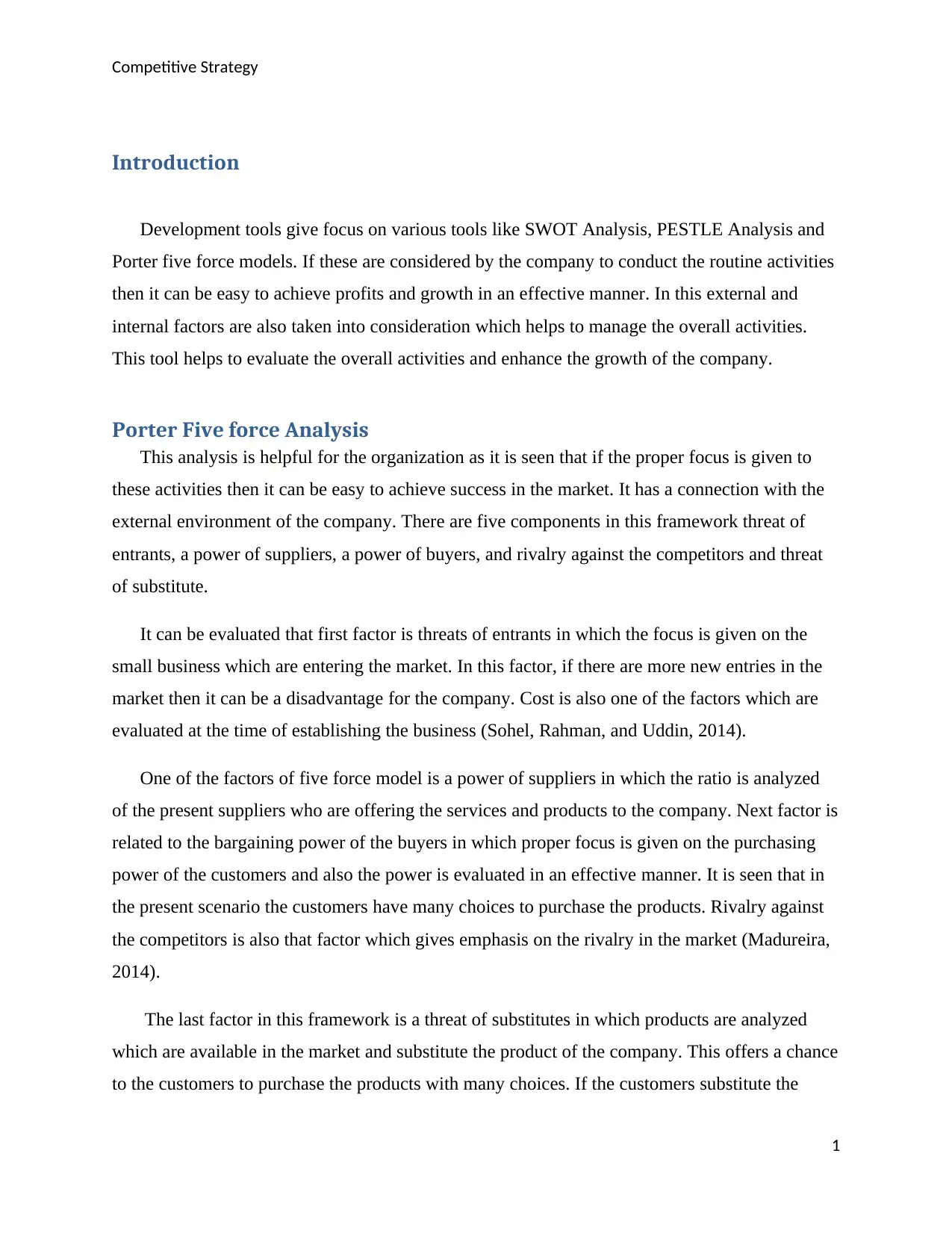
Competitive Strategy
Introduction
Development tools give focus on various tools like SWOT Analysis, PESTLE Analysis and
Porter five force models. If these are considered by the company to conduct the routine activities
then it can be easy to achieve profits and growth in an effective manner. In this external and
internal factors are also taken into consideration which helps to manage the overall activities.
This tool helps to evaluate the overall activities and enhance the growth of the company.
Porter Five force Analysis
This analysis is helpful for the organization as it is seen that if the proper focus is given to
these activities then it can be easy to achieve success in the market. It has a connection with the
external environment of the company. There are five components in this framework threat of
entrants, a power of suppliers, a power of buyers, and rivalry against the competitors and threat
of substitute.
It can be evaluated that first factor is threats of entrants in which the focus is given on the
small business which are entering the market. In this factor, if there are more new entries in the
market then it can be a disadvantage for the company. Cost is also one of the factors which are
evaluated at the time of establishing the business (Sohel, Rahman, and Uddin, 2014).
One of the factors of five force model is a power of suppliers in which the ratio is analyzed
of the present suppliers who are offering the services and products to the company. Next factor is
related to the bargaining power of the buyers in which proper focus is given on the purchasing
power of the customers and also the power is evaluated in an effective manner. It is seen that in
the present scenario the customers have many choices to purchase the products. Rivalry against
the competitors is also that factor which gives emphasis on the rivalry in the market (Madureira,
2014).
The last factor in this framework is a threat of substitutes in which products are analyzed
which are available in the market and substitute the product of the company. This offers a chance
to the customers to purchase the products with many choices. If the customers substitute the
1
Introduction
Development tools give focus on various tools like SWOT Analysis, PESTLE Analysis and
Porter five force models. If these are considered by the company to conduct the routine activities
then it can be easy to achieve profits and growth in an effective manner. In this external and
internal factors are also taken into consideration which helps to manage the overall activities.
This tool helps to evaluate the overall activities and enhance the growth of the company.
Porter Five force Analysis
This analysis is helpful for the organization as it is seen that if the proper focus is given to
these activities then it can be easy to achieve success in the market. It has a connection with the
external environment of the company. There are five components in this framework threat of
entrants, a power of suppliers, a power of buyers, and rivalry against the competitors and threat
of substitute.
It can be evaluated that first factor is threats of entrants in which the focus is given on the
small business which are entering the market. In this factor, if there are more new entries in the
market then it can be a disadvantage for the company. Cost is also one of the factors which are
evaluated at the time of establishing the business (Sohel, Rahman, and Uddin, 2014).
One of the factors of five force model is a power of suppliers in which the ratio is analyzed
of the present suppliers who are offering the services and products to the company. Next factor is
related to the bargaining power of the buyers in which proper focus is given on the purchasing
power of the customers and also the power is evaluated in an effective manner. It is seen that in
the present scenario the customers have many choices to purchase the products. Rivalry against
the competitors is also that factor which gives emphasis on the rivalry in the market (Madureira,
2014).
The last factor in this framework is a threat of substitutes in which products are analyzed
which are available in the market and substitute the product of the company. This offers a chance
to the customers to purchase the products with many choices. If the customers substitute the
1
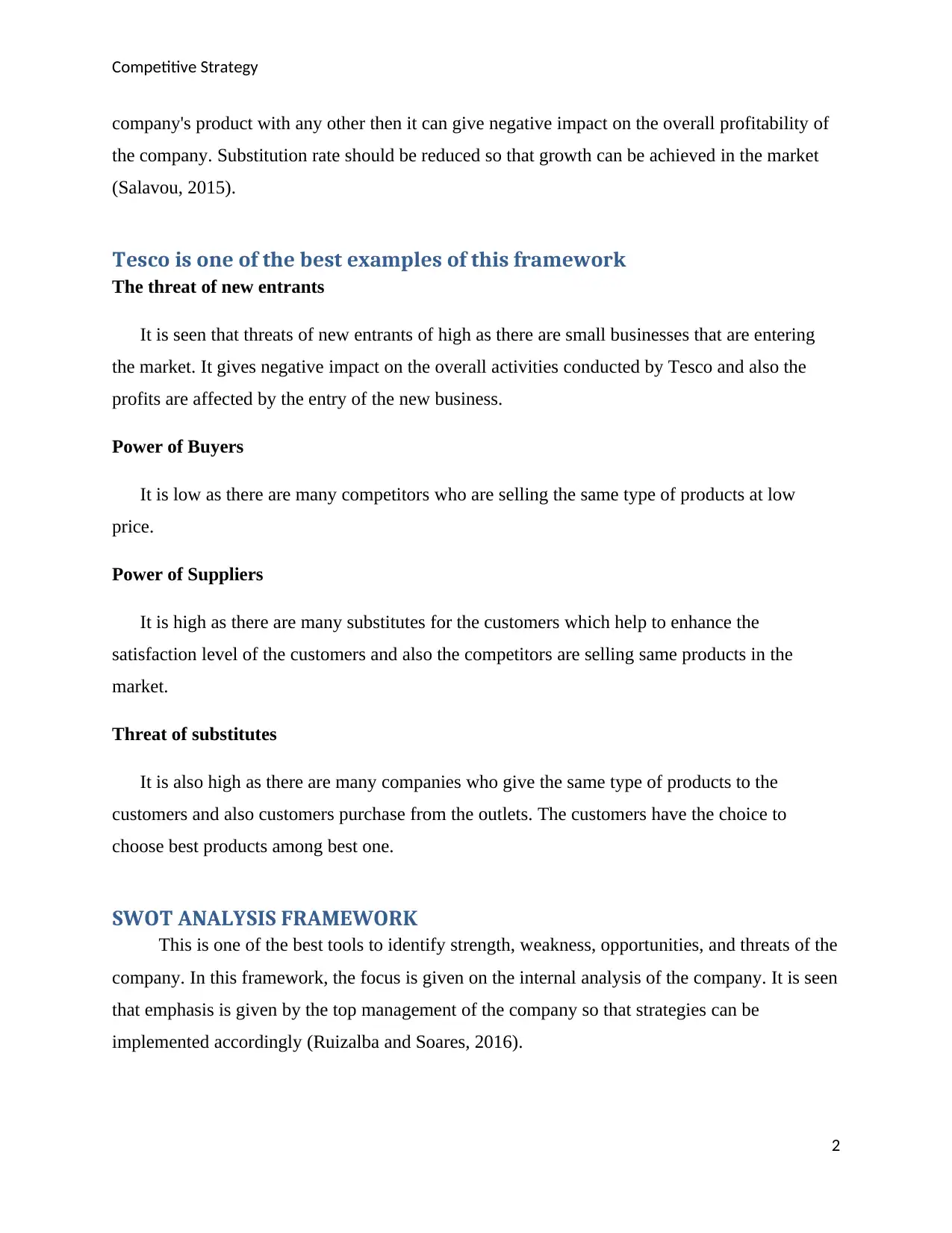
Competitive Strategy
company's product with any other then it can give negative impact on the overall profitability of
the company. Substitution rate should be reduced so that growth can be achieved in the market
(Salavou, 2015).
Tesco is one of the best examples of this framework
The threat of new entrants
It is seen that threats of new entrants of high as there are small businesses that are entering
the market. It gives negative impact on the overall activities conducted by Tesco and also the
profits are affected by the entry of the new business.
Power of Buyers
It is low as there are many competitors who are selling the same type of products at low
price.
Power of Suppliers
It is high as there are many substitutes for the customers which help to enhance the
satisfaction level of the customers and also the competitors are selling same products in the
market.
Threat of substitutes
It is also high as there are many companies who give the same type of products to the
customers and also customers purchase from the outlets. The customers have the choice to
choose best products among best one.
SWOT ANALYSIS FRAMEWORK
This is one of the best tools to identify strength, weakness, opportunities, and threats of the
company. In this framework, the focus is given on the internal analysis of the company. It is seen
that emphasis is given by the top management of the company so that strategies can be
implemented accordingly (Ruizalba and Soares, 2016).
2
company's product with any other then it can give negative impact on the overall profitability of
the company. Substitution rate should be reduced so that growth can be achieved in the market
(Salavou, 2015).
Tesco is one of the best examples of this framework
The threat of new entrants
It is seen that threats of new entrants of high as there are small businesses that are entering
the market. It gives negative impact on the overall activities conducted by Tesco and also the
profits are affected by the entry of the new business.
Power of Buyers
It is low as there are many competitors who are selling the same type of products at low
price.
Power of Suppliers
It is high as there are many substitutes for the customers which help to enhance the
satisfaction level of the customers and also the competitors are selling same products in the
market.
Threat of substitutes
It is also high as there are many companies who give the same type of products to the
customers and also customers purchase from the outlets. The customers have the choice to
choose best products among best one.
SWOT ANALYSIS FRAMEWORK
This is one of the best tools to identify strength, weakness, opportunities, and threats of the
company. In this framework, the focus is given on the internal analysis of the company. It is seen
that emphasis is given by the top management of the company so that strategies can be
implemented accordingly (Ruizalba and Soares, 2016).
2
⊘ This is a preview!⊘
Do you want full access?
Subscribe today to unlock all pages.

Trusted by 1+ million students worldwide
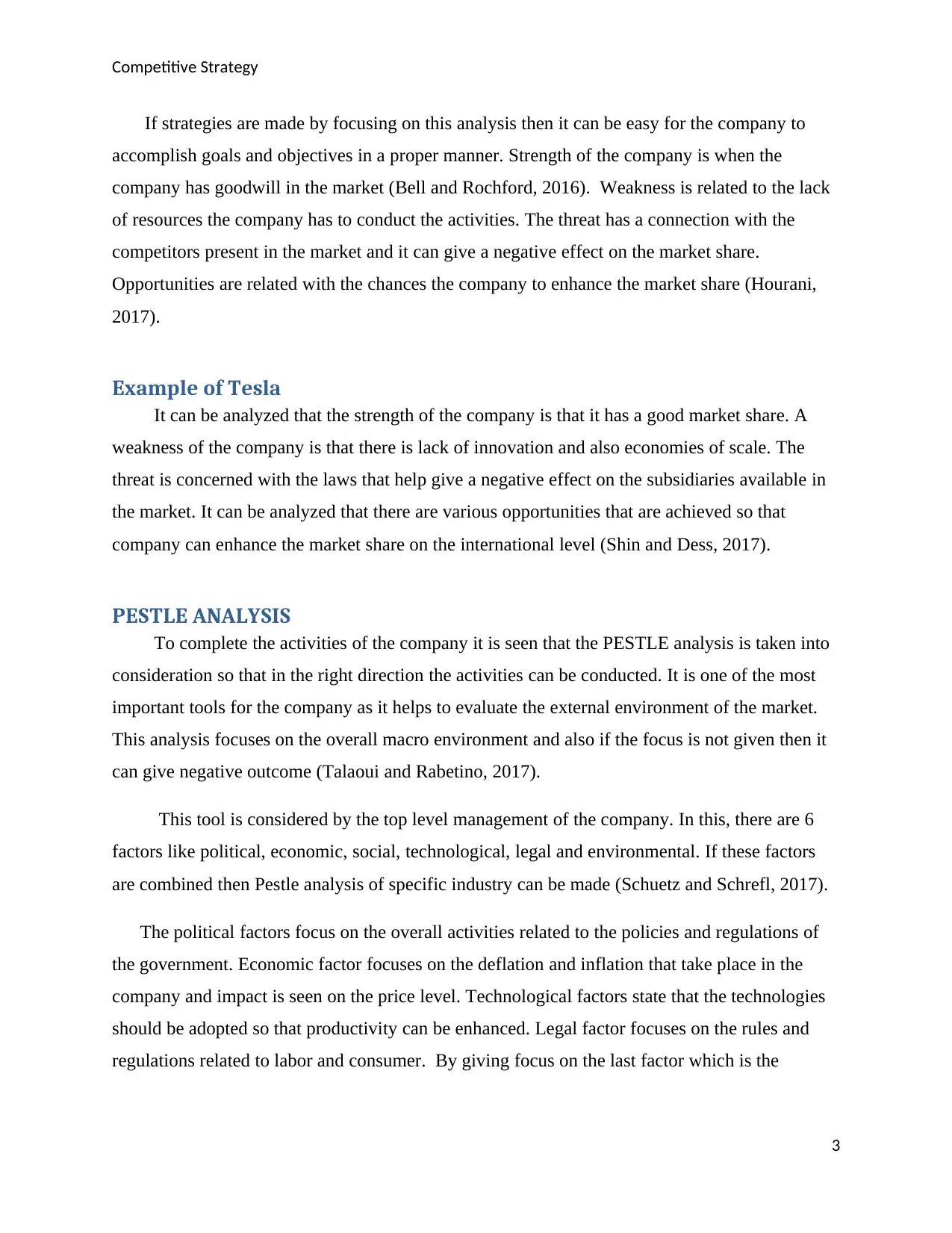
Competitive Strategy
If strategies are made by focusing on this analysis then it can be easy for the company to
accomplish goals and objectives in a proper manner. Strength of the company is when the
company has goodwill in the market (Bell and Rochford, 2016). Weakness is related to the lack
of resources the company has to conduct the activities. The threat has a connection with the
competitors present in the market and it can give a negative effect on the market share.
Opportunities are related with the chances the company to enhance the market share (Hourani,
2017).
Example of Tesla
It can be analyzed that the strength of the company is that it has a good market share. A
weakness of the company is that there is lack of innovation and also economies of scale. The
threat is concerned with the laws that help give a negative effect on the subsidiaries available in
the market. It can be analyzed that there are various opportunities that are achieved so that
company can enhance the market share on the international level (Shin and Dess, 2017).
PESTLE ANALYSIS
To complete the activities of the company it is seen that the PESTLE analysis is taken into
consideration so that in the right direction the activities can be conducted. It is one of the most
important tools for the company as it helps to evaluate the external environment of the market.
This analysis focuses on the overall macro environment and also if the focus is not given then it
can give negative outcome (Talaoui and Rabetino, 2017).
This tool is considered by the top level management of the company. In this, there are 6
factors like political, economic, social, technological, legal and environmental. If these factors
are combined then Pestle analysis of specific industry can be made (Schuetz and Schrefl, 2017).
The political factors focus on the overall activities related to the policies and regulations of
the government. Economic factor focuses on the deflation and inflation that take place in the
company and impact is seen on the price level. Technological factors state that the technologies
should be adopted so that productivity can be enhanced. Legal factor focuses on the rules and
regulations related to labor and consumer. By giving focus on the last factor which is the
3
If strategies are made by focusing on this analysis then it can be easy for the company to
accomplish goals and objectives in a proper manner. Strength of the company is when the
company has goodwill in the market (Bell and Rochford, 2016). Weakness is related to the lack
of resources the company has to conduct the activities. The threat has a connection with the
competitors present in the market and it can give a negative effect on the market share.
Opportunities are related with the chances the company to enhance the market share (Hourani,
2017).
Example of Tesla
It can be analyzed that the strength of the company is that it has a good market share. A
weakness of the company is that there is lack of innovation and also economies of scale. The
threat is concerned with the laws that help give a negative effect on the subsidiaries available in
the market. It can be analyzed that there are various opportunities that are achieved so that
company can enhance the market share on the international level (Shin and Dess, 2017).
PESTLE ANALYSIS
To complete the activities of the company it is seen that the PESTLE analysis is taken into
consideration so that in the right direction the activities can be conducted. It is one of the most
important tools for the company as it helps to evaluate the external environment of the market.
This analysis focuses on the overall macro environment and also if the focus is not given then it
can give negative outcome (Talaoui and Rabetino, 2017).
This tool is considered by the top level management of the company. In this, there are 6
factors like political, economic, social, technological, legal and environmental. If these factors
are combined then Pestle analysis of specific industry can be made (Schuetz and Schrefl, 2017).
The political factors focus on the overall activities related to the policies and regulations of
the government. Economic factor focuses on the deflation and inflation that take place in the
company and impact is seen on the price level. Technological factors state that the technologies
should be adopted so that productivity can be enhanced. Legal factor focuses on the rules and
regulations related to labor and consumer. By giving focus on the last factor which is the
3
Paraphrase This Document
Need a fresh take? Get an instant paraphrase of this document with our AI Paraphraser
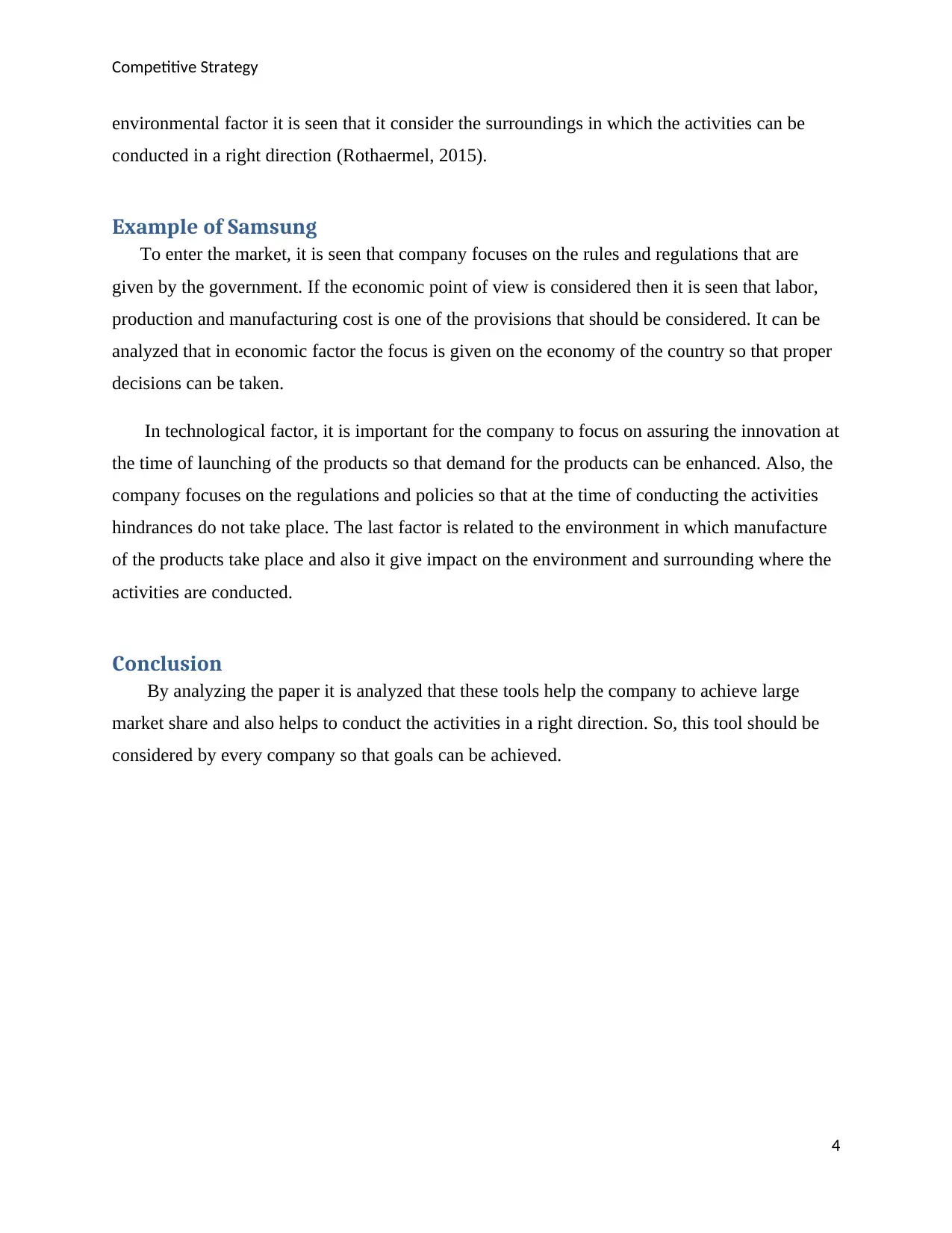
Competitive Strategy
environmental factor it is seen that it consider the surroundings in which the activities can be
conducted in a right direction (Rothaermel, 2015).
Example of Samsung
To enter the market, it is seen that company focuses on the rules and regulations that are
given by the government. If the economic point of view is considered then it is seen that labor,
production and manufacturing cost is one of the provisions that should be considered. It can be
analyzed that in economic factor the focus is given on the economy of the country so that proper
decisions can be taken.
In technological factor, it is important for the company to focus on assuring the innovation at
the time of launching of the products so that demand for the products can be enhanced. Also, the
company focuses on the regulations and policies so that at the time of conducting the activities
hindrances do not take place. The last factor is related to the environment in which manufacture
of the products take place and also it give impact on the environment and surrounding where the
activities are conducted.
Conclusion
By analyzing the paper it is analyzed that these tools help the company to achieve large
market share and also helps to conduct the activities in a right direction. So, this tool should be
considered by every company so that goals can be achieved.
4
environmental factor it is seen that it consider the surroundings in which the activities can be
conducted in a right direction (Rothaermel, 2015).
Example of Samsung
To enter the market, it is seen that company focuses on the rules and regulations that are
given by the government. If the economic point of view is considered then it is seen that labor,
production and manufacturing cost is one of the provisions that should be considered. It can be
analyzed that in economic factor the focus is given on the economy of the country so that proper
decisions can be taken.
In technological factor, it is important for the company to focus on assuring the innovation at
the time of launching of the products so that demand for the products can be enhanced. Also, the
company focuses on the regulations and policies so that at the time of conducting the activities
hindrances do not take place. The last factor is related to the environment in which manufacture
of the products take place and also it give impact on the environment and surrounding where the
activities are conducted.
Conclusion
By analyzing the paper it is analyzed that these tools help the company to achieve large
market share and also helps to conduct the activities in a right direction. So, this tool should be
considered by every company so that goals can be achieved.
4
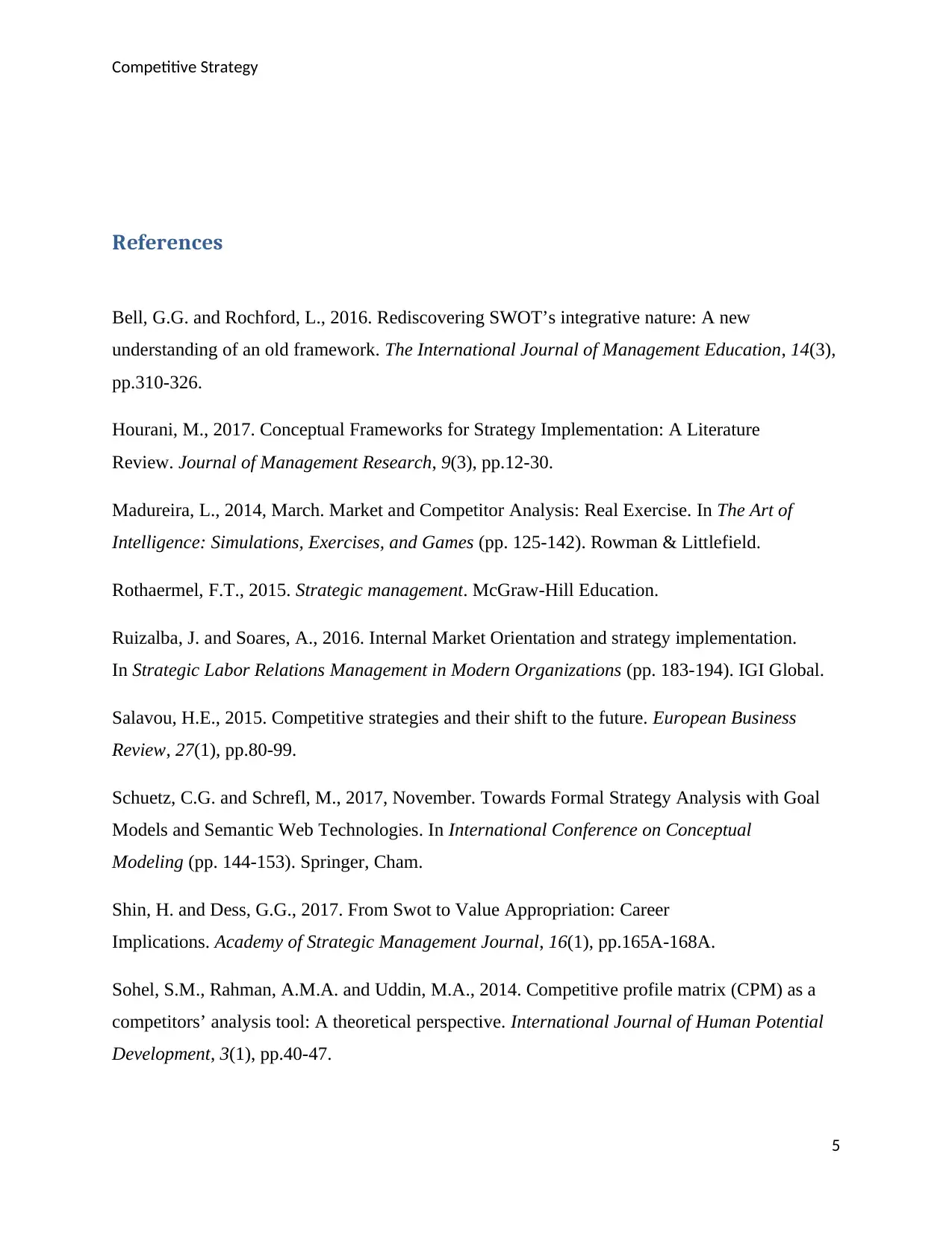
Competitive Strategy
References
Bell, G.G. and Rochford, L., 2016. Rediscovering SWOT’s integrative nature: A new
understanding of an old framework. The International Journal of Management Education, 14(3),
pp.310-326.
Hourani, M., 2017. Conceptual Frameworks for Strategy Implementation: A Literature
Review. Journal of Management Research, 9(3), pp.12-30.
Madureira, L., 2014, March. Market and Competitor Analysis: Real Exercise. In The Art of
Intelligence: Simulations, Exercises, and Games (pp. 125-142). Rowman & Littlefield.
Rothaermel, F.T., 2015. Strategic management. McGraw-Hill Education.
Ruizalba, J. and Soares, A., 2016. Internal Market Orientation and strategy implementation.
In Strategic Labor Relations Management in Modern Organizations (pp. 183-194). IGI Global.
Salavou, H.E., 2015. Competitive strategies and their shift to the future. European Business
Review, 27(1), pp.80-99.
Schuetz, C.G. and Schrefl, M., 2017, November. Towards Formal Strategy Analysis with Goal
Models and Semantic Web Technologies. In International Conference on Conceptual
Modeling (pp. 144-153). Springer, Cham.
Shin, H. and Dess, G.G., 2017. From Swot to Value Appropriation: Career
Implications. Academy of Strategic Management Journal, 16(1), pp.165A-168A.
Sohel, S.M., Rahman, A.M.A. and Uddin, M.A., 2014. Competitive profile matrix (CPM) as a
competitors’ analysis tool: A theoretical perspective. International Journal of Human Potential
Development, 3(1), pp.40-47.
5
References
Bell, G.G. and Rochford, L., 2016. Rediscovering SWOT’s integrative nature: A new
understanding of an old framework. The International Journal of Management Education, 14(3),
pp.310-326.
Hourani, M., 2017. Conceptual Frameworks for Strategy Implementation: A Literature
Review. Journal of Management Research, 9(3), pp.12-30.
Madureira, L., 2014, March. Market and Competitor Analysis: Real Exercise. In The Art of
Intelligence: Simulations, Exercises, and Games (pp. 125-142). Rowman & Littlefield.
Rothaermel, F.T., 2015. Strategic management. McGraw-Hill Education.
Ruizalba, J. and Soares, A., 2016. Internal Market Orientation and strategy implementation.
In Strategic Labor Relations Management in Modern Organizations (pp. 183-194). IGI Global.
Salavou, H.E., 2015. Competitive strategies and their shift to the future. European Business
Review, 27(1), pp.80-99.
Schuetz, C.G. and Schrefl, M., 2017, November. Towards Formal Strategy Analysis with Goal
Models and Semantic Web Technologies. In International Conference on Conceptual
Modeling (pp. 144-153). Springer, Cham.
Shin, H. and Dess, G.G., 2017. From Swot to Value Appropriation: Career
Implications. Academy of Strategic Management Journal, 16(1), pp.165A-168A.
Sohel, S.M., Rahman, A.M.A. and Uddin, M.A., 2014. Competitive profile matrix (CPM) as a
competitors’ analysis tool: A theoretical perspective. International Journal of Human Potential
Development, 3(1), pp.40-47.
5
⊘ This is a preview!⊘
Do you want full access?
Subscribe today to unlock all pages.

Trusted by 1+ million students worldwide
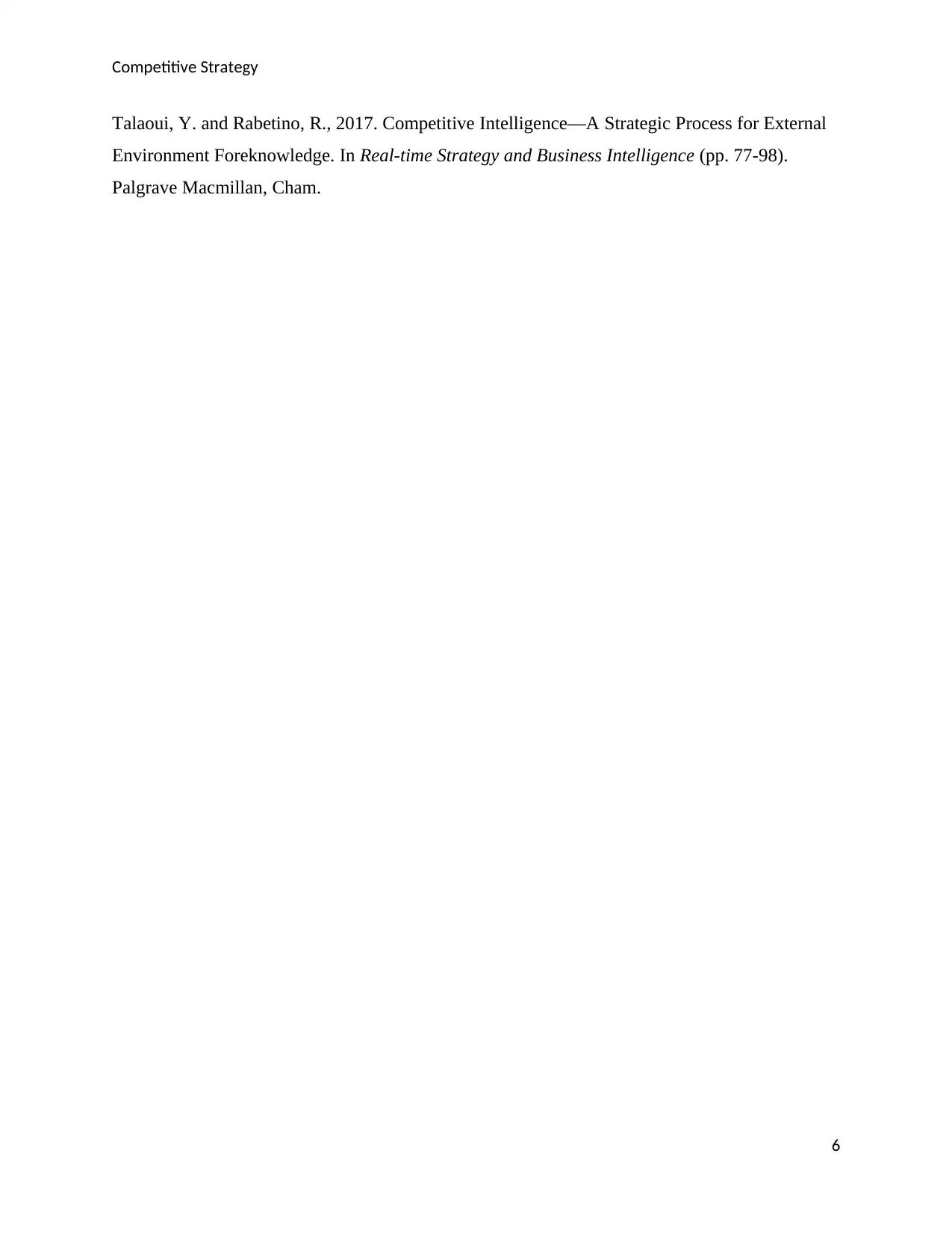
Competitive Strategy
Talaoui, Y. and Rabetino, R., 2017. Competitive Intelligence—A Strategic Process for External
Environment Foreknowledge. In Real-time Strategy and Business Intelligence (pp. 77-98).
Palgrave Macmillan, Cham.
6
Talaoui, Y. and Rabetino, R., 2017. Competitive Intelligence—A Strategic Process for External
Environment Foreknowledge. In Real-time Strategy and Business Intelligence (pp. 77-98).
Palgrave Macmillan, Cham.
6
1 out of 7
Related Documents
Your All-in-One AI-Powered Toolkit for Academic Success.
+13062052269
info@desklib.com
Available 24*7 on WhatsApp / Email
![[object Object]](/_next/static/media/star-bottom.7253800d.svg)
Unlock your academic potential
Copyright © 2020–2025 A2Z Services. All Rights Reserved. Developed and managed by ZUCOL.



